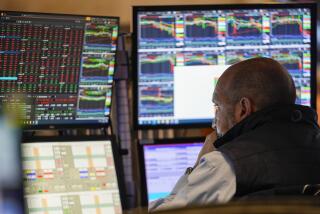Equity Funds Top Leading Market Indexes : Mutuals’ 7.77% Rise Surpasses Dow, S
- Share via
Mutual funds that invest in the little guys of corporate America fared best as a group in the first quarter of 1988, as equity funds on average beat the leading stock market indexes for a second consecutive quarter for the first time in five years.
Figures released Thursday made the funds’ stock pickers look good, as the average equity fund rose 7.77%. That compared to a 3.46% return, including reinvested dividends, for the Dow Jones industrial average and a 5.69% return for the Standard & Poor’s index of 500 large companies.
Not since the first half of 1983 have fund managers beaten the market in back-to-back quarters as they have since Oct. 1, said A. Michael Lipper, president of Lipper Analytical Services, a Summit, N.J., firm that tracks fund performance and compiled the latest numbers.
Few 1st-Quarter Sellers
Most fund managers buy shares in a mixture of large and small companies, and their results thus have lagged major market indexes during the long boom in big corporations’ share prices. But the stocks of little firms spurted ahead in the first quarter, with small company growth funds climbing 14.05% to lead all categories of funds.
Natural resource funds came in second, up 10.4%, while specialty funds that invest in a specific industry finished third, up 9.64%.
Small companies were due for an upward bounce in price, Lipper said. “They did so poorly in the 1984-87 market that they eventually got to a price relative to other stocks that was attractive.”
Most investors who were pessimistic about small-company stocks had sold their positions by the start of the year, so few sellers were left during the first quarter, he added.
‘Terribly Attractive’
Small companies had become underpriced partly because so much money has sluiced into index funds, which invest in the big companies that make up such indexes as the S&P; 500, said Sheldon Jacobs, editor and publisher of No-Load Fund Investor, a newsletter produced in Hastings-on-Hudson, N.Y.
“The P/Es on the small company growth funds have been beaten down to the point where they are terribly attractive,” he said, refering to the ratio of price to earnings per share.
Fixed-income funds, which invest in bonds and hugely outsell equity funds, rose 3.73%. These funds tend to provide more steady but less spectacular gains than equity funds because much of their return comes from regular interest payments by bond issuers.
Gold funds placed last for the quarter, falling 7.63% as gold prices stagnated and inflation fears eased. These funds have had highly variable results in the past 20 quarters, having led all fund categories five times and come in dead last seven times, Lipper pointed out.
The first quarter’s best-performing fund was tiny Strategic Capital Gains, based in Dallas. With 35% of its $3 million in assets invested in a single oil-technology firm in Denver, the fund boomed to a 36.76% gain when a major oil company bought a large stake in the technology firm, doubling its share price, chairman Leroy Brenna said.
Brenna contends the fund is worth its relatively steep sales charge of 8.5% on investments of less than $500,000. “Even at 8.5%, that’s half the price you tip your waiter,” he said. “A broker deserves it.”
Fidelity Magellan, the nation’s largest mutual fund with $8.4 billion in assets, gained 9.98% in the first quarter, a company spokeswoman said.
Two funds investing in Japanese stocks topped the one-year performance tables. DFA Japanese Small Company Portfolio and G. T. Japan Growth Fund benefited from the remarkable comeback staged by the Japanese stock market since the October crash. On Thursday, the Nikkei index closed for the first time above its pre-crash record high.
DFA Japanese, a $76-million no-load fund that only began accepting retail investments a week ago, benefited from the double whammy of investing in small companies and in Japan. The fund does not pick stocks but invests in virtually all companies quoted on the Tokyo stock exchange and worth between $60 and $500 million, said William E. Gordon, a portfolio manager for Dimensional Fund Advisors in Santa Monica.
“Given it’s a passive strategy, that we’re not doing any picking . . . you never expect to turn out No. 1,” he said. “It embarrasses the hell out of people who are picking.”
MUTUAL FUND PERFORMANCE (Appreciation plus reinvested income and capital gains) QUARTER ENDED March 31, 1988
Top Performers Strategic Capital Gains +36.76% Integrated Equity--Aggr Gwth +31.32 44 Wall Street Equity +26.65 Parnassus Fund +25.25 Shearson Lehman Small Capital +24.89 Federated Growth Trust +22.12 Colonial Small Stock Index +22.10 First Investors Discovery +21.61 Ariel Growth +20.30 Fidelity Select Retail +20.13 All funds average +6.18 S&P; 500 (dividends reinvested) +5.69 Worst Performers Strategic Investments -19.36% US Gold Shares -15.73 US Prospector Fund -14.63 USAA Gold -11.83 Financial Porfolio--Gold -11.04 New England Zenith Cap Growth -10.61 Fidelity Select Prec Metals -10.57 Van Eck Gold/Resources -9.44 Steadman Oceanographic -9.27 Keystone Precious Metals -9.18
YEAR ENDED March 31, 1988
Top Performers DFA Japanese Small Company +86.73% GT Japan Growth +74.74 Dreyfus Strategic Aggr Invest +65.70 Oppenheimer Ninety-Ten +49.57 Japan Fund +42.94 Nomura Pacific Basin +34.45 PaineWebber Master Global +22.13 Oppenheimer Gold & Sp Minerals +22.05 Transatlantic Income +19.97 Oppenheimer Premium Income +19.05 All funds average -4.76 S&P; 500 (dividends reinvested) -8.34 Worst Performers 44 Wall Street Equity -48.54% 44 Wall Street -47.42 Fidelity Select Brokerage -43.13 Steadman Oceanographic -40.67 Strategic Investments -38.00 American Capital OTC -37.05 Amercian Capital Growth -35.57 Financial Portfolio-Gold -34.98 Kaufman Fund -33.73 USAA Gold -32.72
FIVE YEARS ENDED March 31, 1988
Top Performers Merrill Lynch Pacific +361.10% Japan Fund +359.71 Vanguard World--Intl Growth +280.81 BB&K; International +279.05 T. Rowe Price Intl Fund +210.54 Putnam Intl Equities +202.81 GT Pacific Growth Fund +185.12 Scudder International +182.01 Transatlantic Growth Fund +178.35 Alliance International +174.08 All funds average +72.80 S&P; 500 (dividends reinvested) +105.99 Worst Performers 44 Wall Street -82.63% American Heritage Fund -60.02 44 Wall Street Equity -41.03 Steadman Oceanographic -40.95 Strategic Investments -39.66 Steadman American Industry -37.17 Industry Fund of America -34.91 First Investors Discovery -30.04 Interstate Capital Growth -26.38 First Investors Fund for Growth -25.51
GROUP PERFORMANCE (periods ended March 31, 1988)
Quarter Year Five Years Small Company Growth Funds +14.05% -12.50% +50.77% Natural Resources Funds +10.40 -6.06 +75.09 Specialty Funds +9.64 -12.09 +77.68 Health Funds +9.37 -16.14 +59.73 International Funds +9.04 +7.39 +209.50 Convertible Securities Funds +7.62 -8.02 +66.42 Growth Funds +7.50 -9.62 +64.32 Science & Technology Funds +7.33 -13.55 +29.24 Capital Appreciation Funds +7.24 -10.06 +49.74 Global Funds +6.87 -4.23 +123.25 Growth & Income Funds +6.78 -6.29 +86.96 Equity Income Funds +6.46 -5.46 +84.89 Option Income Funds +6.38 -5.55 +59.30 Income Funds +5.29 -0.69 +69.57 Utility Funds +5.15 -5.83 +104.81 Balanced Funds +5.03 -3.27 +90.05 Fixed Income Funds +3.73 +2.44 +69.13 World Income Funds +1.28 +13.04 +123.07 Option Growth Funds +1.26 +9.15 +56.90 Gold-Oriented Funds -7.63 -15.62 +15.63 Average all funds +6.18 -4.76 +72.80 S&P; 500 (dividends reinvested) +5.69 -8.34 +105.99
Source: Lipper Analytical Services
More to Read
Inside the business of entertainment
The Wide Shot brings you news, analysis and insights on everything from streaming wars to production — and what it all means for the future.
You may occasionally receive promotional content from the Los Angeles Times.










